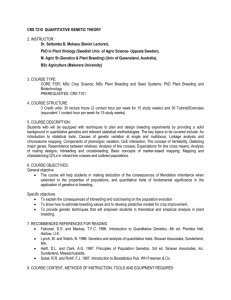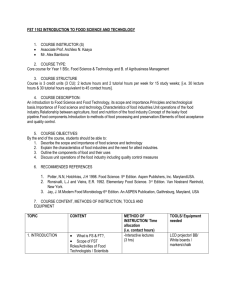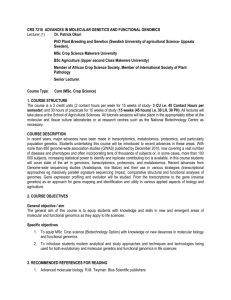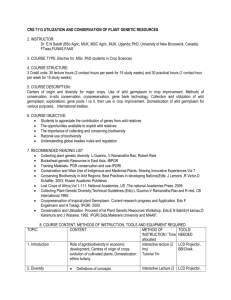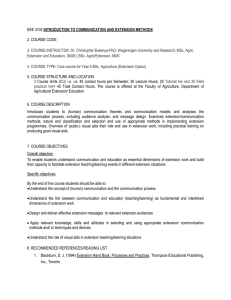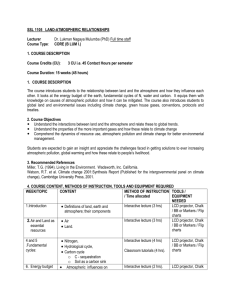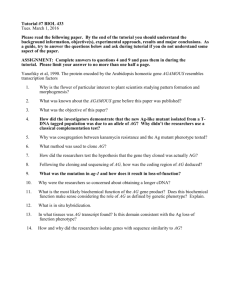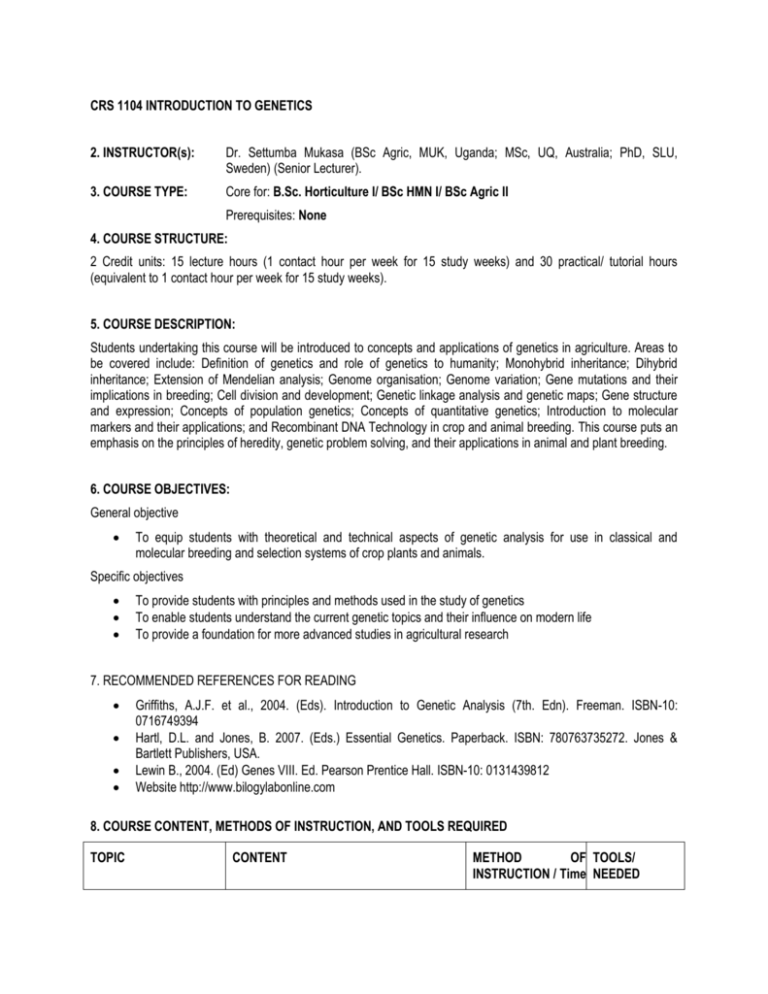
CRS 1104 INTRODUCTION TO GENETICS
2. INSTRUCTOR(s):
Dr. Settumba Mukasa (BSc Agric, MUK, Uganda; MSc, UQ, Australia; PhD, SLU,
Sweden) (Senior Lecturer).
3. COURSE TYPE:
Core for: B.Sc. Horticulture I/ BSc HMN I/ BSc Agric II
Prerequisites: None
4. COURSE STRUCTURE:
2 Credit units: 15 lecture hours (1 contact hour per week for 15 study weeks) and 30 practical/ tutorial hours
(equivalent to 1 contact hour per week for 15 study weeks).
5. COURSE DESCRIPTION:
Students undertaking this course will be introduced to concepts and applications of genetics in agriculture. Areas to
be covered include: Definition of genetics and role of genetics to humanity; Monohybrid inheritance; Dihybrid
inheritance; Extension of Mendelian analysis; Genome organisation; Genome variation; Gene mutations and their
implications in breeding; Cell division and development; Genetic linkage analysis and genetic maps; Gene structure
and expression; Concepts of population genetics; Concepts of quantitative genetics; Introduction to molecular
markers and their applications; and Recombinant DNA Technology in crop and animal breeding. This course puts an
emphasis on the principles of heredity, genetic problem solving, and their applications in animal and plant breeding.
6. COURSE OBJECTIVES:
General objective
To equip students with theoretical and technical aspects of genetic analysis for use in classical and
molecular breeding and selection systems of crop plants and animals.
Specific objectives
To provide students with principles and methods used in the study of genetics
To enable students understand the current genetic topics and their influence on modern life
To provide a foundation for more advanced studies in agricultural research
7. RECOMMENDED REFERENCES FOR READING
Griffiths, A.J.F. et al., 2004. (Eds). Introduction to Genetic Analysis (7th. Edn). Freeman. ISBN-10:
0716749394
Hartl, D.L. and Jones, B. 2007. (Eds.) Essential Genetics. Paperback. ISBN: 780763735272. Jones &
Bartlett Publishers, USA.
Lewin B., 2004. (Ed) Genes VIII. Ed. Pearson Prentice Hall. ISBN-10: 0131439812
Website http://www.bilogylabonline.com
8. COURSE CONTENT, METHODS OF INSTRUCTION, AND TOOLS REQUIRED
TOPIC
CONTENT
METHOD
OF TOOLS/
INSTRUCTION / Time NEEDED
allocated
1. Introduction
Definition of genetics
Role of genetics to humanity
History of genetics in plant and animal
breeding
Interactive lecture (1 LCD Projector,
hr)
BB/Chalk.
Tutorial (2 hrs)
2.
inheritance
Monohybrid
5.
Extension
Mendelian analysis
Intra-allelic interactions: incomplete and
co-dominance
Lethal genes, Pleiotropism
Penetrance and expressivity
Exercises: Mendelian inheritance
Lecture (1 hr)
Multiple alleles
Sex linkage in plants and animals
Inter-allelic interactions: epistasis
Tutorial 1: The chi-square test
Lecture (1 hr)
Definition of a genome
Examples of genomes
Chromosome structure
Tutorial 2: Karyotypes
Lecture (1 hr)
Chromosome mutation
Aneuploidy and euploidy
Polyploidy and plant breeding
Excursion: Genetic variation
Lecture (1 hrs)
Gene mutations
Types and causes of mutations
Transposable elements
Practical 1: Mitosis
Lecture (1 hr)
Mitosis and the cell cycle
Meiosis, gametogenesis
Lecture (1 hr)
of
of
6. Genome organisation
7. Genome variation
Lecture (1 hr)
3. Dihybrid inheritance
4.
Extension
Mendelian analysis
Mendel’s monohybrid crosses.
Genes and alleles defined
The law of segregation
Assignment 1: Probability as applied to
genetics
Mendelian dihybrid experiments
Law of independent assortment
Dihybrid test cross
Assignment 2: The punnet square
8. Gene mutations and
their importance
9.
Cell
division
and
LCD Projector,
BB/Chalk
Tutorial (2 hrs)
Lecture (1 hr)
BB/Chalk,
Transport (140
pple)
to
Practical -field tour (3
MUARIK.
hrs)
BB/Chalk,
Transport (140
pple)
to
Practical -field tour (3
MUARIK.
hrs)
LCD Projector,
BB/Chalk
Tutorial/exercises
hr)
(1
BB/Chalk,
Microscopes,
Practical - laboratory Laboratory
(3 hrs)
pple x 2)
(70
BB/Chalk,
Practical - laboratory
(2 hrs)
Microscopes
and accessories
LCD Projector,
BB/Chalk.
Tutorial/exercises
hrs)
(2
LCD Projector,
development
10. Genetic
analysis
linkage
11.
Concepts
population genetics
12.
Concepts
quantitative genetics
Contrast meiosis and mitosis
Sex determination and linkage
Practical 2: Meiosis
The concept of linkage
Recombination and gene linkage
Three-point test cross
Linkage maps and mapping
Tutorial 3: Recombination frequencies
Tutorial (2 hrs)
Lecture (1 hr)
LCD Projector,
BB/Chalk.
Tutorial/exercises
hrs)
of
Concept of a gene pool
The Hardy-Weinberg equilibrium
Evolutionary aspects
Practical 3: Random genetic drift
Lecture (1 hrs)
of
Quantitative traits
Genotype-phenotype relationship
Estimating genetic variance
Tutorial 4: Heritability estimate
Lecture (1 hr)
Genes at a molecular level;
Transcription and Translation
Gene regulation in eukaryotes
Tutorial 5: Gene regulation
Lecture (1 hr)
13. Gene structure and
expression
14.
Introduction
to
molecular markers and
their application
15. Recombinant DNA
Technology
16-17
The basis of molecular makers
Types of molecular markers
Tutorial 6: Application of molecular
markers in breeding
Definition of gene cloning
Gene cloning procedure
Recombinant DNA technology
Assignment 4: Applications of
recombinant DNA to agriculture
Lab (70 pple x
2)
(2
BB/Chalk,
Handouts,
Practical - laboratory Lab materials
(3 hrs)
(70 pple x 2)
LCD Projector,
BB/Chalk
Tutorial/exercises
hrs)
(2
LCD Projector,
BB/Chalk
Tutorial/exercises
hrs)
(1
Lecture (1 hr)
LCD Projector,
BB/Chalk
Tutorial/exercises
hr)
(1
Interactive lecture (1 LCD Projector,
hr)
BB/Chalk
Tutorial (1 hr)
Revision Time
Final Examination
9. SUMMARY OF TIME NEEDED:
Lectures
15 (30) hrs
Tutorials (and assignments)
15 hrs
Practicals
15 hrs
10. COURSE ASSESSMENT:
Continuous assessment
(Quizzes tests):
Three (3) quizzes and tests arising from tutorials and 30%
assignments during semester week 5, 10 and 15.
Continuous assessment
(Practicals):
Students will write 3 practical reports
University Examination:
Final examination during week 16-17 of the semester
10%
60%

